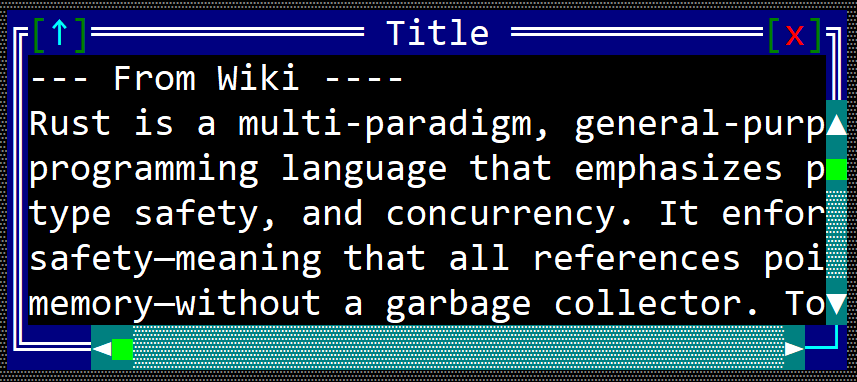Canvas
Represent a surface that can be drawn under a view-port:

To create a canvas use Canvas::new method (with 3 parameters: a size, a layout and initialization flags).
let b = Canvas::new(Size::new(30,10), layout!("x:10,y:5,w:15"),canvas::Flags::None);
or the macro canvas!
let b1 = canvas!("30x10,x:10,y:5,w:15");
let b2 = canvas!("'30,10',x:10,y:5,w:15");
A canvas supports all common parameters (as they are described in Instantiate via Macros section). Besides them, the following named parameters are also accepted:
| Parameter name | Type | Positional parameter | Purpose |
|---|---|---|---|
size or sz or surface | Size | Yes (first postional parameter) | The size of the surface within the canvas |
flags | String | No | canvas initialization flags |
back or backgroud | char! format | No | A character as describes in Macro Builds - the same as with the char! macro format |
lsm or left-scroll-margin | Numeric | No | The left margin of the bottom scroll bar in characters. If not provided the default value is 0. This should be a positive number and it only has an effect if the flag Scrollbars was set up. |
tsm or top-scroll-margin | Numeric | No | The top margin of the right scroll bar in characters. If not provided the default value is 0. This should be a positive number and it only has an effect if the flag Scrollbars was set up. |
A canvas supports the following initialization flags:
canvas::Flags::ScrollBarsorScrollBars(for macro initialization) - thils enable a set of scrollbars that can be used to change the view of the inner surface, but only when the control has focus, as described in Components section.
Some examples that uses these paramateres:
- A canvas with a backgroud that consists in the character
Xin withAquaandDarkBluecolors.let c = canvas!("size:10x5,x:10,y:5,w:15,back={X,fore:aqua,back:darkblue}"); - A canvas with scrollbars with different margins
let c = canvas!("sz:'10 x 5',x:10,y:5,w:15,flags:Scrollbars,lsm:5,tsm:1");
Events
A canvas emits no events.
Methods
Besides the Common methods for all Controls a canvas also has the following aditional methods:
| Method | Purpose |
|---|---|
drawing_surface_mut(...) | Returns the inner surface that can be dranw into the canvas |
resize_surface(...) | Resizes the inner surface of the canvas |
set_backgound(...) | Sets the character used for background |
clear_background() | Remove the background character making the background transparent. |
Key association
The following keys are processed by a canvas control if it has focus:
| Key | Purpose |
|---|---|
Left,Right,Up,Down | Move the view port to a specified direction by one character. |
Shift+Left | Moves the horizontal view port coordonate to 0 |
Shift+Up | Moves the vertical view port coordonate to 0 |
Shift+Right | Moves the horizontal view port coordonate so that the right side of the inner surface is displayed |
Shift+Down | Moves the vertical view port coordonate so that the bottom side of the inner surface is displayed |
Ctrl+{Left,Right,Up,Down} | Move the view port to a specified direction by a number of characters that is equal to the width for Left/Right or height for Up/Down. |
PageUp, PageDown | has the same effect as Ctrl+{Up or Down} |
Home | Moves the view port to the coordonates (0,0) |
End | Moves the view port so that the bottom-right part of the inner surface is visible |
Example
The following code uses a canvas to create a viewer over the Rust language definition from wikipedia:
use appcui::prelude::*;
static text: &str = r"--- From Wiki ----
Rust is a multi-paradigm, general-purpose
programming language that emphasizes performance,
type safety, and concurrency. It enforces memory
safety—meaning that all references point to valid
memory—without a garbage collector. To
simultaneously enforce memory safety and prevent
data races, its 'borrow checker' tracks the object
lifetime of all references in a program during
compilation. Rust was influenced by ideas from
functional programming, including immutability,
higher-order functions, and algebraic data types.
It is popular for systems programming.
From: https://en.wikipedia.org/wiki/Rust_(programming_language)
";
fn main() -> Result<(), appcui::system::Error> {
let mut a = App::new().size(Size::new(60,20)).build()?;
let mut w = window!("Title,a:c,w:40,h:8,flags:Sizeable");
let mut c = canvas!("'60x15',d:f,flags=ScrollBars,lsm:3,tsm:1");
let s = c.drawing_surface_mut();
s.write_string(0, 0, text, CharAttribute::with_color(Color::White, Color::Black), true);
w.add(c);
a.add_window(w);
a.run();
Ok(())
}